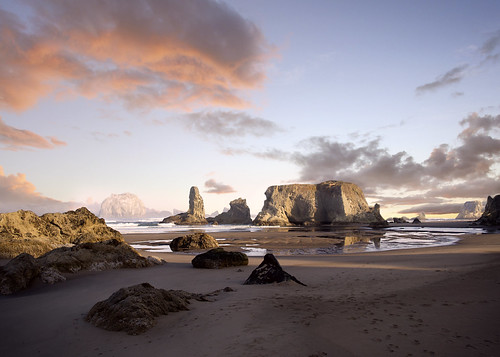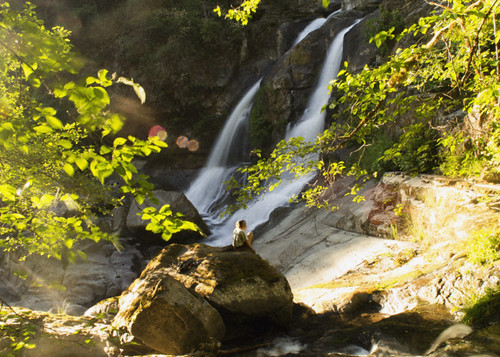There is a piece of vital information about science I feel I need to share at this point in the summer. Be advised, this may come as a bit of a shock. Scientists are people too. Every single one of us – human beings. If you are a scientist or know a scientist, you should know this. And if you’re reading this now and know me personally, I hope that you at least somewhat recognized this already. However, I accept that it can be easy to completely forget about the human dimension of this increasingly computerized, data-driven behemoth we call science. Last week provided me with ample examples of how we science geeks are just as human as anybody else.
It began with the 4th of July last Tuesday. While the laws of nature may never take a day off, the people studying them certainly do. I spent the day at the beach with a couple other Sea Grant scholars and a handful of the REUs here at Hatfield Marine Science Center. Let me take a moment to say that every one of my fellow interns is incredibly bright. Each intern is collaborating with other scientists, conducting high level research on topics that range from oyster antibiotics to deep-sea volcanoes. I’ve had some great conversations over the past few weeks and learned a ton, because I’m living in close quarters with a group of geniuses. However, our collective genius is probably not always fully apparent. For example, we spent a significant portion of beach time trying to push one another out of a small circle in the sand while playing the classic Independence Day game “Beach Sumo”. Hey, even geniuses need to blow off some steam. We grilled out, played some more conventional 4th of July games (e.g. beach volleyball), and watched the local fireworks just like any other collection of human beings might on America’s birthday. And the next day, it was right back to work in the lab and/or office.
Actually, for me, I wasn’t in the lab or office the next day. Instead I spent the day on a work road trip. Scientists take road trips too. Remember SMURFing? Well we took this road trip down to pick up the fish collected in SMURFs by our collaborators in Port Orford. I travelled with Will, a Ph.D. student at Oregon State studying juvenile rockfish, and Madeline, an REU student working with Will for the summer. The drive to Port Orford is a long one and we filled it with naps, swapping stories, and jamming to mid-90s grunge music. Once we arrived, though, it was all science again. We were somewhat disappointed to have driven four hours to pick up only five fish, but that’s all that had been collected from the SMURFs that morning. As the old saying goes, science is as science does. Rather than turn tail and retreat to Newport immediately though, we chose to take matters into our own hands. The three of us donned our wetsuits and hiked down some 300+ steps at a former coast guard station to reach a beautiful protected cove where we snorkeled for about an hour, collecting fish with nets. Fieldwork is awesome. When the sheer cold of Oregon’s waters finally overpowered the warmth we felt from the beauty of our surroundings (and, more importantly, our wetsuits) we loaded up in the car and drove back to Newport in high spirits. A few days later Will, Maddy, and I went snorkeling for juveniles again, this time in Newport. Conditions were much more difficult. I don’t want to shame Maddy and myself with exact numbers, but the number of fish captured collectively by the two of us was borderline pathetic. In contrast, Will raked in 20 fish all by himself. If I hadn’t personally witnessed him eating a gigantic burrito an hour later, I might believe that perhaps he actually is a fish-catching robot, rather than human.
I spent the most of the rest of my week working on writing up posts for the Marine Reserves website. Not to brag or anything, but the ODFW Marine Reserves Program has a fantastic website. If you have any interest in Oregon’s oceans, marine conservation, or just have a spare 10 minutes I encourage you to check it out at http://oregonmarinereserves.com/. There’s some great information and photos on there about the reserves and the hard work we do here to monitor them. Over the course of the summer I’ll be writing several posts for the news section on the homepage, covering topics such as SMURFing, sea star wasting syndrome, and some of the other projects I work with. The first post went up last Friday if you’re interested!
Writing these posts has gotten me thinking about all of the similar scientific material I’ve read either online or in print. All of these public posts and articles are written by real human people whether you believe it or not. And although the writing style is generally one that intentionally emphasizes the information over the author, I think some of the writer’s personality often leaks into the text whether they intend it or not. In my opinion, this is a good thing for communicating with the public. Making scientific information communicable involves expressing it in a way that interests the public. We’re all social creatures (even scientists), so we’re more interested in things that sound like they were written by humans rather than robots. Most people prefer novels over dictionaries, for example. Next time you’re reading something scientific –whether it’s in a newspaper, magazine, online, etc. – take a second and think about the person who wrote it. Can you tell a little bit about them just by reading it? Maybe they’re a distinguished Ph.D. with hundreds of publications. Or maybe they’re a slightly hungry 22-year-old who is two days late on their weekly blogging deadline, kind of like me!
I do have a (somewhat) decent excuse for being a little late with this post. I spent this weekend camping at Mount Hood with the other Hatfield interns, as well as a group of REUs from Corvallis. That’s right, scientists camp too. The trip was originally planned just for the REUs, but the director of Hatfield’s REU program is awesome and permitted myself and a few other non-REUs to tag along. It was spectacular. We hiked a total of about 20 miles in some 48 hours, the highlight being a 12 mile hike that traversed rivers, boulders, meadows, and mini-snow fields, and ended on a ridge overlooking the majestic Mount Hood. All of this was enhanced by the great group of people surrounding me. We joke around, dance in the moonlight, float down freezing cold streams, have snowball fights/duels/ambushes, and so on and so on. We’re all 100% human, but also 100% scientist, and if there’s enough other students out there who are similar to us, our oceans are in good hands for the future.




 far, we have found: the feisty Dungeness crab, the “always looks kind of dead” shiner perch, the slimy gunnel, the abundant stickleback, the English sole that looks like Flats the Flounder from SpongeBob, and my favorite the staghorn sculpin (the namesake of my favorite IPA). The days are long and tiring, but to me zooming around on a boat and tromping through mud all day feels doesn’t really feel like work.
far, we have found: the feisty Dungeness crab, the “always looks kind of dead” shiner perch, the slimy gunnel, the abundant stickleback, the English sole that looks like Flats the Flounder from SpongeBob, and my favorite the staghorn sculpin (the namesake of my favorite IPA). The days are long and tiring, but to me zooming around on a boat and tromping through mud all day feels doesn’t really feel like work.





























